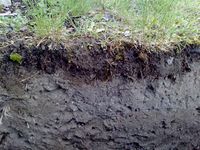Difference between revisions of "Soil"
m (Agriculture category) |
(image+) |
||
| Line 1: | Line 1: | ||
| + | [[Image:soilSectional.jpg|thumb|right|200px|soil under grassland - a view into the ditch]] | ||
| + | |||
'''Soil''' is the natural medium for [[:category:plants|plants]] to grow in. It provides [[water|moisture]], nutrients and a mechanical foothold. Soil comes into existence in close interaction with living plants and a variety of [[microbes]] and [[insects]]. Since [[Mars]] does not host life, the existence of natural soil is not possible. Soil may play an important part in an [[autonomous colony]] for [[food]] production. | '''Soil''' is the natural medium for [[:category:plants|plants]] to grow in. It provides [[water|moisture]], nutrients and a mechanical foothold. Soil comes into existence in close interaction with living plants and a variety of [[microbes]] and [[insects]]. Since [[Mars]] does not host life, the existence of natural soil is not possible. Soil may play an important part in an [[autonomous colony]] for [[food]] production. | ||
Revision as of 11:03, 25 May 2010
Soil is the natural medium for plants to grow in. It provides moisture, nutrients and a mechanical foothold. Soil comes into existence in close interaction with living plants and a variety of microbes and insects. Since Mars does not host life, the existence of natural soil is not possible. Soil may play an important part in an autonomous colony for food production.
Composition and structure
Natural soil contains mineral parts, such as sand and clay. Additionally, it contains a variable part of organic matter, such as decomposed pieces of plants and humus. The third part is a complex population of microbes and insects, living in numerous small spaces between the grains and making soil a living system.
Biological stability
The living part of the soil is in a constant process of renewal and evolution. It needs energy to carry out the metabolism in every single organism. Many microbes and insects are living in symbiosis with each other and with the plants, growing in the soil. Yet, the complexity is not fully understood. Soil can, therefore, not be preserved for large periods of time.
Artificial soil
Soil can not be made artificially, but a kind of pre-soil can be made to speed up the development of real soil. In botanical nurseries the pre-soil is a mixture of sand, clay and shreddered organic waste. It does not contain substantial living parts, such as microbes and insects. The addition of compost and fertilizer would be a great enhancement.
After placing the pre-soil in an environment with living plants and natural soil the pre-soil is transformed to natural soil by immigration of microbes, insects and plant roots. The pre-soil provides a good structure and nutrients for those immigrants.
In a young Martian colony there is a lack of organic waste, making it hard to make a good pre-soil mixture. None or very little organic matter can be added to the mineral part. Under these conditions the production of soil takes a long period of time. Pioneer plants can help to accelerate the process.
Open issues
- How long can soil be held alive in a dark container (e.g. for transportation)?
- What temperature range is required to keep soil alive?
- What species (microbes and insects) are necessary for a functioning symbiosis with plants?
- How long does it take to develop soil from pre-soil (under Martian conditions with regolith as the mineral part)? An experiment should be carried out.







